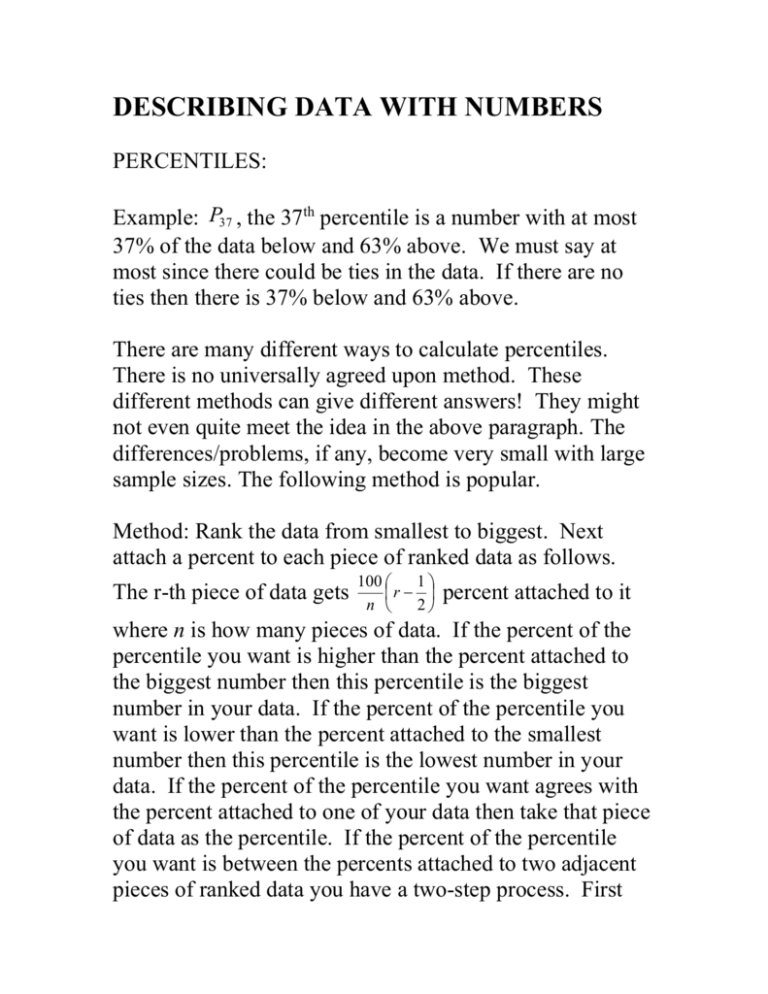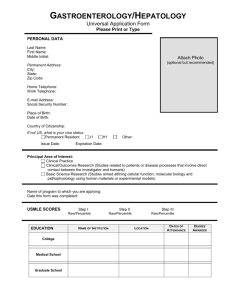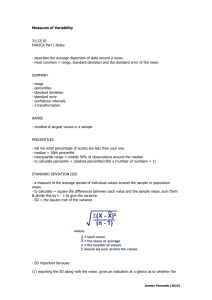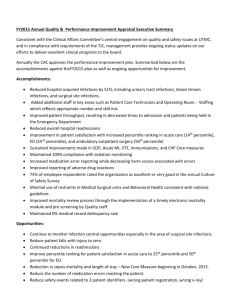Slides in MS Word - Colorado Mesa University
advertisement

DESCRIBING DATA WITH NUMBERS PERCENTILES: Example: P37 , the 37th percentile is a number with at most 37% of the data below and 63% above. We must say at most since there could be ties in the data. If there are no ties then there is 37% below and 63% above. There are many different ways to calculate percentiles. There is no universally agreed upon method. These different methods can give different answers! They might not even quite meet the idea in the above paragraph. The differences/problems, if any, become very small with large sample sizes. The following method is popular. Method: Rank the data from smallest to biggest. Next attach a percent to each piece of ranked data as follows. The r-th piece of data gets 100 1 r n 2 percent attached to it where n is how many pieces of data. If the percent of the percentile you want is higher than the percent attached to the biggest number then this percentile is the biggest number in your data. If the percent of the percentile you want is lower than the percent attached to the smallest number then this percentile is the lowest number in your data. If the percent of the percentile you want agrees with the percent attached to one of your data then take that piece of data as the percentile. If the percent of the percentile you want is between the percents attached to two adjacent pieces of ranked data you have a two-step process. First find what percent of the way the percent you are interested in is from the smaller percent to the larger percent. Then the percentile you are interested in is this percent (found in the first step) of the way from the smaller piece of data to the larger piece of data. Let’s check this method out with a couple of simple examples that we could perhaps do just by inspection and see if it agrees. Example: Consider the data set 2, 3, 5. What is the 50th percentile? _____ Using the method above we have the following table: r = rank 1 2 3 Data 2 3 5 Attached percent 16.6666% 50% 83.3333333% So the method gives the 50th percentile to be 3. Hopefully this agrees with our intuitive guess. Example: Consider the data set 2, 3, 5, 9. What is the 50th percentile? ______ Using the method above we have the following table: r = rank 1 2 3 4 Data 2 3 5 9 Attached percent 12.5% 37.5% 62.5% 87.5% The 50% is between 37.5% and 62.5%. The distance from 37.5% to 62.5% is 25%. 50% is 12.5% higher than 37.5%. So 50% is 12.5%/25% or 50% of the way from 37.5% and 62.5%. So we must go 50% of the way between 3 and 5, so we get 4. Hopefully this agrees with our intuitive guess above. For practice let’s also find the 8th percentile and the 81st percentile in the above example. The 8th percentile is 2 since 8% is below 12.5. The 81st percentile is between 5 and 9. The distance between 62.5% and 87.5% is 25%. 81% is 18.5% of the way from 62.5% and 87.5%. So we must go 18.5%/25% = 74% of the way from 5 to 9. From 5 to 9 is 4 and 74% of 4 is 2.96. So the 81st percentile is 5+2.96 = 7.96. Some common percentiles are as follows: MEDIAN = P50 Q1 P25 Q3 P75 Note that if you have many pieces of data and only care about these common percentiles you need not attach percents to each piece of data. You just need to attach percents on either side of 25, 50, and 75. With quartiles and medians they will always be either exactly a piece of your data, half way between two pieces of data, or ¼ or ¾ of the way in between two pieces of data. _ SAMPLE MEAN = x x n SAMPLE STANDARD DEVIATION x x n 2 _ s | x x | n 1 2 2 n 1 So why is there an n-1 on the bottom (the population standard deviation had a N on the bottom)? Turns out we need the n-1 instead of n so that s is nearly an unbiased estimator of (with an n on the bottom it under estimates). Also consider an example in which we have a sample of size 1, say the data is 22. From this you can find the sample mean (22) and it is an unbiased estimator (perhaps not very reliable) of the population mean. But from 1 piece of data you have absolutely no idea about how the data is spread out in the population. So it makes sense that s should not be able to be calculated (can’t divide by 0) since you have no idea about what you really care about, namely . The sample mean and standard deviation are better for symmetric data without skewness or outliers. If these problems occur, the 5 number summary (min, Q1, median, Q3, max) is usually better. Example: Suppose we want to find out how much on average each person is worth financially in this class. This may be OK, but if Bill Gates walks in then the average would be over a billion dollars, a somewhat meaningless number, in this case the median is better. The median wouldn’t change much (you would count ½ of a piece of data further) Both the mean and the median represent the middle, but they can be quite different. Many data such as house prices and incomes are skewed to the right. In these cases the mean is higher than the median. If the NBA players were to go on strike the players would probably want the _______ reported and the owners would probably want the _______ reported. Box plot: a graph of the 5-number summary, a box is made with Q1, the median and Q3 and then there are whiskers to the min and the max You might want to check out the following website that lets you play with the mean and the median. http://illuminations.nctm.org/activitydetail.aspx?ID=160 1.5 IQR rule (for checking for outliers) : an outlier is any piece of data more than 1.5 IQR’s above Q3 or below Q1. IQR = Q3 – Q1 Roughly the interval from Q1 to Q3 tells you what? It tells where the middle half of the data is. Suppose you have not raw data, but data already grouped, how would you estimate the sample mean and standard deviation? Assume each data was in the middle of its group. Example: Estimate the sample mean and standard deviation for the sample data summarized by: Data range How many? 4 0 x 10 10 x 20 3 20 x 30 1 30 x 40 2 What if you are finding the average age for a sample of people and you get 48.2 years. Because of the way people report ages _____ is a better estimate for the population mean because on average each person will be about ______ older than they report. You can usually see if your sample mean seems reasonable, but what about the sample standard deviation. Well, there is a very rough estimate for s: H L where H and L are the 4 highest and lowest numbers. This is good when the data is close to normal and has around 20 pieces of data. Why? With normal data 95% is within +/- 2 standard deviations and 95% of around 20 pieces of data is basically all of it. This estimate can be really bad if the data is not close to normal or if there are a lot of pieces of data. This estimate is only to see if your calculation of s might seem reasonable.







